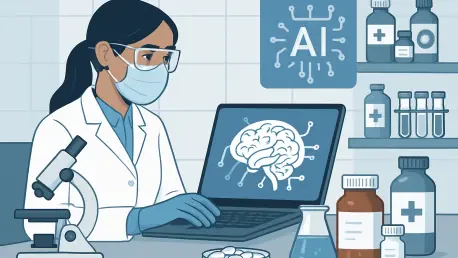In a transformative move for the pharmaceutical industry, the European Medicines Agency (EMA) has unveiled draft updates to its Good Manufacturing Practices (GMP) guidelines, focusing on the integration of artificial intelligence (AI) and data governance to address the challenges of a rapidly digitizing landscape. Released for public consultation on July 7, 2025, with feedback welcomed until October 7, 2025, these documents mark a critical juncture in aligning regulatory frameworks with technological innovation. The updates include a significantly revised Annex 11 on computerized systems, a pioneering Annex 22 dedicated to AI, and an expanded Chapter 4 of the GMP guidelines related to documentation. This initiative underscores the EMA’s commitment to ensuring patient safety, product quality, and data integrity while navigating the complexities of modern tools. By harmonizing with global regulatory trends, such as those seen with the U.S. Food and Drug Administration (FDA), the EMA aims to set a robust foundation for future advancements. These guidelines highlight a careful balance between embracing cutting-edge solutions and maintaining stringent oversight, making them a focal point for industry stakeholders eager to adapt without risking compliance. The implications of these changes promise to shape how technology is leveraged in pharmaceutical manufacturing, offering both opportunities for efficiency and challenges in meeting new regulatory expectations.
Integrating Technology into GMP Frameworks
The updated guidelines from the EMA reflect a profound shift toward embedding technology as a core component of GMP compliance in pharmaceutical operations. Annex 11, now expanded from a mere five pages to a comprehensive 19, addresses the intricacies of computerized systems with detailed provisions for aspects like cloud services, data life cycle management, and system security. This revision acknowledges the indispensable role digital tools play in enhancing efficiency and precision across manufacturing and quality assurance processes. Beyond just updating existing standards, the document incorporates modern concepts such as supplier management and periodic system reviews to ensure that technological integration aligns with GMP objectives. The alignment with industry benchmarks like ISPE GAMP 5 further ensures that these regulations are not only forward-thinking but also practical for implementation. As pharmaceutical companies increasingly rely on electronic systems for critical operations, the EMA’s emphasis on robust validation and configuration requirements offers a clear roadmap for maintaining compliance in a digital era.
Another dimension of this technological integration is the EMA’s exploration of AI as a tool for innovation within GMP contexts. Annex 22 represents a groundbreaking step, being the first formal guideline dedicated to AI, though it cautiously limits its scope to static models that do not adapt post-development. This measured approach indicates an awareness of the potential benefits AI can bring, such as improved data analysis and process optimization, while recognizing the risks posed by more dynamic systems. By excluding adaptive or generative AI from critical applications, the EMA ensures that untested technologies do not jeopardize patient safety or product quality. This initial foray into AI governance suggests that while the industry is poised for transformation, regulators are prioritizing a learning phase to better understand these tools before broader adoption is permitted. The balance struck here is crucial for fostering innovation without compromising the stringent standards that define pharmaceutical manufacturing.
Ensuring Data Integrity and Risk Mitigation
Data integrity emerges as a central pillar in the EMA’s updated GMP guidelines, with Annex 11 and Chapter 4 placing significant emphasis on safeguarding electronic information against manipulation or loss. The focus is on creating systems that are not only reliable but also transparent, ensuring that every data point in the manufacturing process can be trusted. By weaving in principles from ICH Q9 on Quality Risk Management, the guidelines mandate thorough assessments to identify vulnerabilities in digital systems, whether they relate to unauthorized access or data corruption. This approach is critical in an environment where electronic records are increasingly replacing paper-based systems, and the potential for errors or breaches grows accordingly. The EMA’s insistence on robust audit trails and security protocols provides a framework that pharmaceutical companies can use to build trust in their processes, reassuring regulators and patients alike that product quality remains uncompromised.
Beyond safeguarding data, the EMA adopts a structured, risk-based methodology to manage the broader challenges introduced by technology in GMP settings. This is evident across all three documents, where risk assessments are required for validating computerized systems, qualifying AI models, and even managing documentation processes. The consistent application of ICH Q9 principles ensures that potential issues are proactively addressed rather than reactively corrected, minimizing the likelihood of non-compliance. For instance, when integrating a new electronic system, companies must evaluate its impact on product quality and patient safety through defined risk parameters, aligning with practical industry standards. This methodical approach not only mitigates risks but also fosters a culture of continuous improvement, as periodic reviews and updates to risk strategies are encouraged. By embedding such rigor into the guidelines, the EMA ensures that technological advancements enhance rather than undermine the integrity of pharmaceutical operations.
Human Oversight in an Automated Era
A standout feature of the EMA’s updated guidelines, particularly in Annex 22, is the principle of “human in the loop” (HITL), which mandates human oversight for critical decisions involving AI systems. This concept serves as a safeguard, ensuring that automated processes do not operate in isolation when they impact GMP outcomes. Whether it’s approving outputs from an AI model or intervening in unexpected deviations, human judgment remains paramount to maintain accountability. This principle acknowledges the power of technology to streamline operations while recognizing its limitations in replacing nuanced decision-making that often requires ethical or contextual considerations. By embedding HITL into the regulatory framework, the EMA ensures that patient safety and product quality are never left solely to algorithms, providing a necessary layer of protection in an increasingly automated industry.
The balance between innovation and caution is further highlighted by the EMA’s conservative stance on the scope of AI applications within GMP. Annex 22 explicitly excludes dynamic AI systems, such as generative models or large language models, from critical processes due to their unpredictable nature. Instead, only static AI models are permitted, and even then, under strict qualification and continuous monitoring to ensure performance aligns with validated parameters. This cautious approach reflects a broader strategy to protect public health while allowing room for technological exploration in non-critical areas. Operational controls, such as change management and deviation handling, are mandated to maintain system integrity over time, ensuring that any drift in performance is promptly addressed. This measured integration of AI demonstrates the EMA’s commitment to learning from initial implementations before expanding the regulatory scope, striking a balance that prioritizes safety without stifling progress.
Documentation as the Backbone of Compliance
Comprehensive documentation stands as a non-negotiable requirement across the EMA’s updated guidelines, ensuring traceability and defensibility in every aspect of GMP compliance. Annex 11 demands detailed records for the validation and operation of computerized systems, covering everything from system configuration to periodic reviews. Similarly, Annex 22 requires exhaustive documentation for AI systems, including data processing methods and decision-making explanations using modern analytical tools like SHAP values for transparency. Chapter 4, now expanded to 17 pages, reinforces the importance of good documentation practices for both electronic and paper records, ensuring that every step in the manufacturing process can withstand regulatory scrutiny. This emphasis on documentation is not merely bureaucratic; it serves as a critical tool for accountability, allowing companies to demonstrate compliance and regulators to verify adherence to standards.
The role of documentation extends beyond mere record-keeping to become a foundation for data governance and risk management within the updated guidelines. Chapter 4 introduces new sections on these topics, highlighting the interplay between electronic systems and the need for structured oversight. The recognition of hybrid systems, where paper and digital records coexist, alongside updated definitions of signatures to include electronic forms, shows the EMA’s adaptation to modern realities. These updates ensure that documentation practices keep pace with technological advancements, maintaining clarity and consistency across diverse operational environments. By prioritizing detailed and accessible records, the EMA provides a mechanism for pharmaceutical companies to navigate the complexities of digital transformation while upholding the integrity of their processes. This focus on documentation ultimately underpins the trust and reliability that are essential to GMP compliance.
Navigating the Future of Pharmaceutical Regulation
Reflecting on the EMA’s draft updates to GMP guidelines, it becomes evident that a pivotal shift has occurred in how technology is integrated into pharmaceutical regulation. The revisions to Annex 11 and Chapter 4, alongside the introduction of Annex 22, demonstrate a proactive effort to address the digital evolution while upholding stringent standards for patient safety and product quality. These documents, released for consultation, capture a moment of cautious optimism, balancing the promise of AI and electronic systems with the need for robust oversight and risk management. The emphasis on human accountability and comprehensive documentation lays a strong foundation for compliance in an increasingly complex landscape.
Looking ahead, the next steps for industry stakeholders involve actively engaging in the consultation process to refine these guidelines further. Companies should prioritize aligning their systems with the proposed standards, particularly in areas like data integrity and AI qualification, to ensure seamless adoption once finalized. Additionally, investing in training for personnel on the “human in the loop” principle will be crucial to maintaining accountability in automated processes. As the EMA continues to learn from initial implementations, future iterations of these guidelines may expand to include more dynamic technologies, offering greater flexibility. For now, the focus remains on building robust frameworks that can adapt over time, ensuring that innovation enhances rather than undermines the core objectives of GMP. This strategic approach promises to guide the pharmaceutical industry through the challenges of digital transformation with clarity and purpose.









